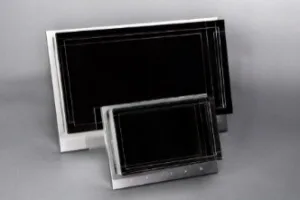The Looking Glass monitor combines lightfield and volumetric technologies within a single new type of display. Multiple viewers can see and interact with the virtual 3D imagery without the need for glasses or a headset.

The company behind the Looking Glass monitor, the Looking Glass Factory Inc., has offices both in Brooklyn, NY for software development and a lab in Hong Kong for hardware prototyping and short run production. The Hong Kong office is represented as close to the company’s manufacturer in mainland China.
The Looking Glass monitor presents virtual 3D content in full color at up to 60fps and is launching in two sizes. The Standard monitor is 8.2 inches wide x 6.1 inches high x 3.7 inches deep and weighs 4.8 pounds. The Large monitor is 14.5 inches wide by 9.6 inched high by 6.9 inches deep and weighs 18.6 pounds. The monitors are illustrated in the figure below.
The Standard and Large Looking Glass monitors.
The technology used in the Looking Glass is described in an allowed U.S. patent application entitled “Printed Plane 3D Volumetric Display.” The application was filed on September 15, 2016, assigned application number 15/266039 and published on March 16, 2017 with publication number 2017-0078655. The only top level comment offered here on the technology is that 45 distinct views of a three dimensional scene are generated so that multiple viewers within the viewing area see different parts of the scene.
The Looking Glass monitor supports hardware configurations including the MacBook Pro Core i5 2.7. However, for the best viewing experience, a computer with the following specifications is recommended:
- Operating system: Windows 10 64 bit.
- CPU: Equivalent to Intel Core i5 or above.
- Graphics card: Equivalent to Nvidia GTX 1060 or above. The Looking Glass only works with graphics cards that are able to output 2560 x 1600 or above.
- RAM: 4GB or above.
- Internal storage:128GB or above.
A video is appended at the end of this article that contains an interview / discussion about the Looking Glass monitor.
The Standard and Large Looking Glass monitors can be tiled together into a 1×2, 2×2 or an even bigger array to produce a larger display volume. In addition, the technology behind the Looking Glass display itself can scale to a larger size. In fact, the company reports that larger displays are under development. Note, however, that the Standard and Large sized monitors in the figure are the only products the company plans to produce in 2018.
The Looking Glass monitor allows for a wide range of peripheral add-ons including the Leap Motion Controller, Nintendo Switch Joy-Con Controllers, Intel RealSense, Microsoft Kinect, Xbox Game Controller and Arduino.
A 3D Model and Animation Importer app developed by the company allows users to view 3D models on their Looking Glass. The user can rotate around their model by left clicking and dragging, pan around the scene by right clicking and dragging and can zoom in by scrolling. In the early beta release of the application, only gLTF, OBJ and glb file formats are accepted but more are promised for the near future. The company has written a brief Model Importer Getting Started Guide to assist early beta users of the Looking Glass.
An exporter directly from Maya will also available with live viewports from Maya, Zbrush, Blender, Tinkercad and Solidworks in development. In addition, a free HoloPlay SDK for Unity is currently available.
Dozens of holographic apps are available for free download using the App Library, included with every Looking Glass shipment. These apps will be both Window PC and MAC executable and serve to manage content for the Looking Glass. With the Library, “the user will be able to browse, download and play holographic content inside their Looking Glass with a single click. These include volumetric video clips, holographic film shorts, lightfield and 3D scan viewer apps, new types of holographic games, virtual pets, CT-scan/DICOM importers, a WYSIWYG 3D model previewer for 3D printing, and much more. At launch, the App Library will include about three dozen holographic applications that the Looking Glass Factory have developed as a small sample of what can be created for the user to experience inside a Looking Glass. The company expects this to grow to hundreds of applications. By the end of the year, creators will also be able to share their own apps via the Library with Looking Glass owners around the world.”
Pricing for the Looking Glass monitor is as follows: The MSRP of the Standard display is $600. The Standard is currently offered at a super early bird price of $450 with delivery during December. An advanced beta of the Standard is on sale now for $999 with shipment even sooner, during September. The MSRP of the Large display is $3,000. The large is currently offered at a super early bird price of $2,500 with delivery during December. An advanced beta is on sale now for $5,000 with shipment even earlier, during September.
The company has launched a Kickstarter fund raising campaign. It can be found here. At the time this article is written, $700,711 has been pledged against a goal of $50,000 by 1,138 backers. Clearly this is a very successful campaign and can be expected to fund on August 23rd.
If the funding hits $750,000, the company has promised that Kickstarter backers who already have or will purchase a Looking Glass will get a free copy of the voxel-based game Voxatron specially ported into the Looking Glass.
Looking Glass Factory is backed by the same investors that funded Formlabs, Makerbot, Sphero, and Occipital reportedly giving the company the funds needed to ensure all orders in the launch are fulfilled. This representation is supported by the fact that the company has produced about 100 early beta Looking Glass monitors during the past few months. -Arthur Berman

